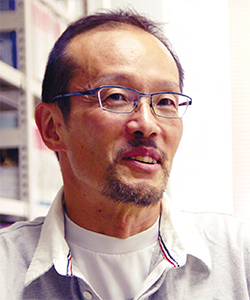Home > Research > Pickup > koji_yoshimura
Using Ultra-High-Precision Lasers to Determine the Nature of Neutrinos:Quest for our universe as the laboratory!

Koji Yoshimura
Professor of Physics
Received his Ph.D. in Physics from the Faculty of Science & Graduate School of Science, University of Tokyo Department of Physics. After serving as a Teaching Associate at the International Center for Elementary Particle Physics (ICEPP), University of Tokyo, he was Classroom Assistant in Physics at The University of Tokyo Department of Physics. Next, he became the Assistant Professor at the Inter-University Research Institute Corporation, High Energy Accelerator Research Organization (KEK). After becoming the research core professor of Okayama University Extreme Quantum Physics, he has served since 2016 as the Professor of Okayama University, at the Research Institute for Interdisciplinary Science (RIIS).
Particles called "neutrinos" have become well-known worldwide after Nobel Prizes in Physics were awarded in 2002 and 2015 for neutrino research. The properties of neutrinos are closely related to the origins of our universe. Neutrinos can also help answer the simple question: "If our universe is filled with particles, why are there almost no antiparticles?" Prof. Yoshimura's research lab is focused on determining the true nature of neutrinos, but their research methods are completely unique, and not found anywhere else.
Are you familiar with the term "antiparticle"? One can describe this term using a mirror: you (particle) are in the world, while your image (antiparticle) is reflected in the mirror. And just as you cannot "pull out" your reflected self from the mirror, antiparticles usually do not appear in our daily lives. Although this sounds like something from science fiction, Carl David Anderson actually discovered the positron*1 (the antiparticle of an electron) in 1932. It is now believed that there is an antiparticle for every known particle. An interesting phenomenon is that of "annihilation": when a particle meets its antiparticle, an enormous amount of energy is released and both particles disappear.
"A strange fact is that while our universe is filled with a variety of 'particles,' we have found almost no antiparticles. This is a major puzzle in physics."
Thus, Professor Yoshimura explains his work.
"The early universe created by the Big Bang had an enormous amount of energy and, strictly speaking, there should have been the same numbers of particles and antiparticles. Yet today we find almost no antiparticles around us. In fact, it is the elementary particle called the neutrino that holds the key for resolving this puzzle."
The puzzle of neutrinos
For the case of ordinary elementary particles, particles and antiparticles are different entities. For example, the positron is the antiparticle of an electron; the electric charge of the positron is the opposite of that of the electron, and thus these two can be said to be different particles.
"Only neutrinos are special.""
A light appears in Dr. Yoshimura's eyes as he speaks.
"Many particle physicists believe that one cannot tell any difference between a neutrino and its antiparticle. These particles are called 'Majorana particles,' yet no one has successfully proven in empirical tests that the neutrino is in fact a Majorana particle."
So why do particle researchers believe that the neutrino is a Majorana particle? Because it is the very nature of the neutrino that holds the key as to why there are almost no antiparticles in today's universe.
"In the early universe, where there were the same quantities of particles and antiparticles, it is thought that the 'large-mass neutrino' existed. While these are the same category of particle as the neutrinos we observe today, due to its huge mass, the large-mass neutrino was unstable, and in a moment this broke down into particles having smaller masses. This disintegration is thought to have resulted in a very slight difference in the number of particles and antiparticles, with particles having the slight majority. The annihilation of the remaining particles and antiparticles is theorized to have led to there being only particles existing today."
One must not forget what Dr. Yoshimura adds next.
"Nevertheless, for this scenario to be believable, it is necessary to first prove that the neutrino is in fact a Majorana particle. For this reason, ascertaining the true nature of the neutrino will help us understand the beginnings of our universe. If we can prove this, surely it will become one of the most important discoveries in human history."
Particle physics experiments in the experimental laboratories of Okayama University
Research on particle physics and the physics of neutrinos usually takes place in giant-sized facilities, such as in huge accelerators and at Super-Kamiokande. For his Nobel Prize in Physics in 2002, Professor Masatoshi Koshiba detected neutrinos from supernovas and our sun as they passed through water and gave off a small Cherenkov radiation glow. In this work, the gigantic Kamiokande facility was used and neutrinos were measured at the 3,000-ton hyper-pure water tank located deep underground in the Earth.
Dr. Yoshimura's lab uses a completely different approach; the attempt is to use an ultra-high-precision laser within an experimental lab of Okayama University to irradiate atoms and molecules, so as to clarify the property of neutrinos within the resulting reactions.
"This is a wonderful method. Although a weak point was the fact that reactions occurred only at extremely low frequencies, we have been able to overcome this point through the use of a new amplification technique called the macro-coherent amplification mechanism. We have already completed the first stage of our proof-of-principle experiments."
Professor Yoshimura concludes with this strong message for all.
"What our lab aims for is to investigate fundamentals of particle physics right here in Okayama University's experimental laboratories, without relying on gigantic experimental facilities. In other words, this is a challenge of ideas: we are trying to create a universe in the laboratory. Our research constitutes a completely new field, one where particle astrophysics are performed in small-scale facilities. This research will be linked with the creation of new scientific principles. We can view the dawn of our universe in the laboratory, and seek to thereby elucidate the origins of the cosmos. We strongly desire that young students full of energy, ideas, and the dreams of frontier science, will actively participate with us in this project."
*1 For this work, Anderson was awarded the Nobel Prize in Physics in 1936.







